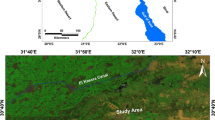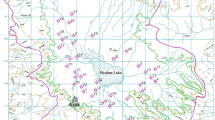Abstract
Groundwater resources are limited, to measure the groundwater and predict the data is a challenging task. Water is the major resource for living being and nonrenewable, hence to model and predict the groundwater is great significance in the present day scenario. In this paper collected the recent datasets of longitude of and latitude of 2018, 2019 depth of groundwater level analyzed and predicted the datasets of Chittoor (Andhra Pradesh, India) and Greater Noida (Gautham Budh Nagar, Uttar Pradesh in India) regions. The proposed machine learning model, by using the Support Vector Machine (SVM)-based binary prediction, the proposed model carries out the effective results and optimized approach. The model is applied in South India region and North India region and compared. Results proved that the proposed approach is a better approach for predicting groundwater table by using SVM-based binary prediction since it also involves optimization.










Similar content being viewed by others
References
Paramaguru PK, Paul JC, Panigrahi B (2019) Estimation of replenishable groundwater resource for sustainable development: a case study for Ghumuda watershed of Odisha. J Soil Water Conserv 18(1):76–84
Samui P (2019) Application of artificial intelligence in geo-engineering. In International conference on information technology in geo-engineering. Springer, Cham, pp 30–44, Sept 2019
Samui P, Kim D, Viswanathan R (2015) Spatial variability of rock depth using adaptive neuro-fuzzy inference system (ANFIS) and multivariate adaptive regression spline (MARS). Environ Earth Sci 73(8):4265–4272
Samui P, Viswanathan R, Jagan J, Kurup PU (2018) Determination of spatial variability of rock depth of Chennai. In: Handbook of research on modeling, analysis, and application of nature-inspired metaheuristic algorithms. IGI Global, pp 462–479
Mallikarjuna B, Reddy DAK (2019) Healthcare application development in mobile and cloud environments. In: Internet of things and personalized healthcare systems. Springer, Singapore, pp 93–103. https://doi.org/10.1007/978-981-13-0866-6_9
Bisht S, Patra BA, Gupta NC, Arora S, Singh RA (2007) Assessment of drinking water quality of Delhi, India. In: Proceedings of the workshop on mass spectrometry
Sattari MT, Mirabbasi R, Sushab RS, Abraham J (2018) Prediction of groundwater level in Ardebil plain using support vector regression and M5 tree model. Groundwater 56(4):636–646
Levin S, Krishnan S, Rajkumar S, Halery N, Balkunde P (2016) Monitoring of fluoride in water samples using a smartphone. Sci Total Environ 551:101–107
Zahra A, Hashmi MZ, Malik RN, Ahmed Z (2014) Enrichment and geo-accumulation of heavy metals and risk assessment of sediments of the Kurang Nallah—feeding tributary of the Rawal Lake Reservoir, Pakistan. Sci Total Environ 470:925–933
Hatton T, Evans R, Merz SK (1997) Dependence of ecosystems on groundwater and its significance to Australia. Sinclair Knight Merz, Sydney
Wardlow B, Anderson T, Tadesse C, Hain W, Rodell M, Thenkabail PS (2016) Remote sensing of drought: emergence of a satellite-based monitoring toolkit for the United States. In: Remote Sensing of Water Resources, Disasters, and Urban Studies, pp 367–398
Exner ME, Perea-Estrada H, Spalding RF (2010) Long-term response of groundwater nitrate concentrations to management regulations in Nebraska’s central Platte Valley. Sci World J 10:286–297
Shi YX, Tao DJ, Wang MN (2008) Prediction of ground surface movement and deformation in constructing large cross-section tunnel by shallow-burying and hidden-digging method. Rock Soil Mech Wuhan 29(2):465
Yang Z, Liu J, Tischer SV, Christmann A, Windisch W, Schnyder H, Grill E (2016) Leveraging abscisic acid receptors for efficient water use in Arabidopsis. Proc Natl Acad Sci 113(24):6791–6796
Nair SS, Sindhu G (2016) Groundwater level forecasting using artificial neural network. Int J Sci Res Publ 6(1):2250–3153
Dogan A, Demirpence H, Cobaner M (2008) Prediction of groundwater levels from lake levels and climate data using ANN approach. Water Sa 34(2):199–208
Bisht D, Jain S, Raju MM (2013) Prediction of water table elevation fluctuation through fuzzy logic & artificial neural networks. Int J Adv Sci Technol 51:107–120
Shahajad M, Mallikarjuna B, Gupta DV, Dohere A, Reddy DAK (2019) Available online through research. Analytical study of transform based techniques on medical images. Int J Pharmacy Technol 11(1):31683–31700
Lohani AK, Krishan G (2015) Groundwater level simulation using artificial neural network in southeast Punjab, India. J Geol Geosci 4(3):206
Jones MT (2008) Artificial intelligence: a systems approach. Laxmi Publications, Ltd., Chennai
Ghadampour Z, Rakhshandehroo G (2010) Using artificial neural network to forecast groundwater depth in union county well. World Acad Sci Eng Technol 62(1):957–960
Kavitha Mayilvaganan M, Naidu KB, Saranya CR, Shobhalatha G, Patil JV, Rao KPR, Ranga Swamy P, Rout SK, Mishra D, Behera AK, Sastry KPR, Sarma KKM, Ch Srinivasarao K, Sujatha GP, Naidu GA, Martanda Krishna K, Sriramamurthy G, Narayana Rao D, Rahamatulla MA, Mehrotra R, Shoeb Ahmad Q, Yadav SK, Lala A (2010) Comparative study of ANN and ANFIS for the prediction of groundwater level of a watershed. Global J Math Sci: Theory Pract 3:299–306
Banerjee P, Prasad RK, Singh VS (2009) Forecasting of groundwater level in hard rock region using artificial neural network. Environ Geol 58(6):1239–1246
Yoon H, Jun SC, Hyun Y, Bae GO, Lee KK (2011) A comparative study of artificial neural networks and support vector machines for predicting groundwater levels in a coastal aquifer. J Hydrol 396(1–2):128–138
Chen ST, Yu PS (2007) Pruning of support vector networks on flood forecasting. J Hydrol 347(1–2):67–78
Liu J, Chang JX, Zhang WG (2009) Groundwater level dynamic prediction based on chaos optimization and support vector machine. In: 2009 third international conference on genetic and evolutionary computing. IEEE, pp 39–43, Oct 2009
Behzad M, Asghari K, Coppola EA Jr (2010) Comparative study of SVMs and ANNs in aquifer water level prediction. J Comput Civil Eng 24(5):408–413
Markner-Jäger B (2008) The groundwater system. In: Technical English for geosciences. Springer, Berlin, pp 134–136
Ram M, Davim JP (eds) (2016) Mathematical concepts and applications in mechanical engineering and mechatronics. IGI Global, Hershey
Qing D, Jian-guo Z, Yan M, Ke L (2010) RVM and SVM for classification in transient stability assessment. In: 2010 Asia-Pacific power and energy engineering conference
Patrick R (2015) When the well runs dry: the slow train wreck of global water scarcity. J Am Water Works Assoc 107(3):65–76
Mallikarjuna B, Viswanathan R, Naib BB (2019) Feedback-based gait identification using deep neural network classification. J Crit Rev 7(4):2020
Baliyan M, Bandooni A, Sharad A, Viswanathan R, Mallikarjuna B, Edison T (2019) Prediction of decay modes of Higgs Boson using classification algorithms. J Crit Rev 7(7):2020
Author information
Authors and Affiliations
Corresponding author
Additional information
Publisher's Note
Springer Nature remains neutral with regard to jurisdictional claims in published maps and institutional affiliations.
Rights and permissions
About this article
Cite this article
Mallikarjuna, B., Sathish, K., Venkata Krishna, P. et al. The effective SVM-based binary prediction of ground water table. Evol. Intel. 14, 779–787 (2021). https://doi.org/10.1007/s12065-020-00447-z
Received:
Revised:
Accepted:
Published:
Issue Date:
DOI: https://doi.org/10.1007/s12065-020-00447-z




